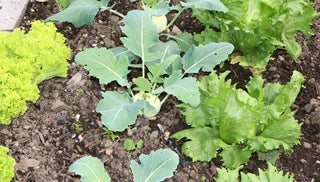
Just like people, plants need good companions to thrive!
Mediterranean gardeners have always put basil and tomatoes together in the kitchen as well as in the garden. Many people believe that the odors from the aromatic oils produced in basil leaves help to repel insects that might otherwise bother the tomato plants. This may or may not be so, but planting them near each other is definitely a good way to combine two tasty crops. When it comes to the science of companion planting, it is difficult to prove any definite cause and effect relationships. Life in the garden is a little different every year, so it is almost impossible to replicate the exact growing conditions from one year to the next.
Broccoli is a good companion to dill.
What is Companion Planting?
Companion planting is when two or more plants are grown near each other for the benefit of at least one (or perhaps all!) of the plants.

5 Benefits of Companion Planting
1. It deters pests: Some plants give off scents or oils that flat out repel harmful insects. Other plants produce scents that help attract beneficial insects that consume pests.
2. It improves soil health: Different plants have different nutrient requirements, but they also interact with the soil in different ways. Planting different families of plants near each other can help modify the soil. Nitrogen-fixing legumes (peas and beans) can actually convert nitrogen in the atmosphere into a form of nitrogen that is usable by plants. Crops with long taproots, like carrots, can help break up and aerate compacted soil.
3. It provides shade: Tall, sun-loving crops like sunflowers and corn can help cool the soil below and provide shade for heat-sensitive plants like spinach and lettuce.
4. It helps reduce weeds: Weeds LOVE to capitalize on open, unplanted soils. Adding a sprawling, leafy vine (like pumpkins or squash) between more upright plants will help minimize the amount of open soil in your garden bed.
5. It improves flavor: Ok, this one has not been confirmed through rigorous scientific testing — but many gardeners swear that certain plant groupings can improve the flavor of their harvests. Chives are throught to improve the flavor of carrots, and basil is said to boost tomato growth and flavor.
Good Companions
Here are a few traditional groupings to try:
| Plant These... | ...With These |
|---|---|
| Beans | Corn, Marigolds, Nasturtium, Peas |
| Broccoli | Dill, Beets, Nasturtium, Onion |
| Corn | Beans, Squash |
| Cucumbers | Nasturtium, Dill, Marigold, Peas |
| Garlic | Tomatoes, Lettuce, Broccoli, Cabbage, Marigold |
| Lettuce | Chives, Broccoli, Carrots, Radish |
| Onions | Beets, Carrots, Parsnips |
| Peas | Beans, Carrot, Cucumber, Corn |
| Peppers | Basil, Onions, Eggplant |
| Potatoes | Beans, Peas, Corn, Marigold, Cilantro |
| Spinach | Strawberries, Peas, Carrots, Cilantro |
| Squash | Nasturtium, Marigold, Corn |
| Tomatoes | Marigold, Basil, Parsley, Spinach, Garlic |
Watch Out For Plant Bullies
Some plants "misbehave" and can push out other plants by one way or another. Mint has a strongly scent that repels lots of insect pests, however it is also an aggressive grower that can overtake an area. Pull up any unwanted stems or confine mint to a container placed near your other crops. Black walnut emits a chemical compound via its roots called jugalone, which inhibits the growth of other plants nearby. Be sure to plant black walnut far from your garden beds.





